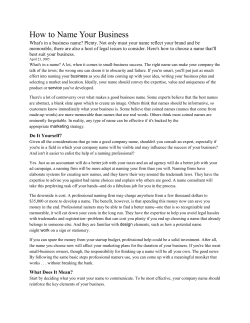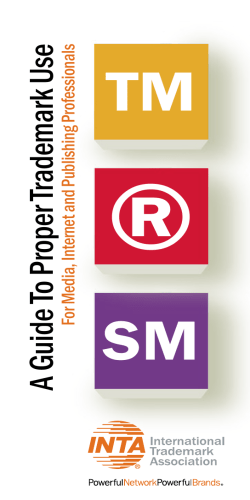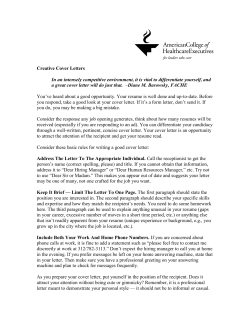
R : BUSINESS LAW TODAY
AS APPEARED IN BUSINESS LAW TODAY A MERICAN R EPRINTED WITH P ERMISSION B AR A SSOCIATION , S ECTION OF B USINESS L AW RESIST CEASE AND DESIST: A LIGHTER APPROACH MAY WORK BETTER WITH TRADEMARKS By Deborah A. Wilcox May/June 2006 • Volume 15 • Number 5 E very day, legally protected trademarks are used without authorization by a company's competitors, customers, critics and counterfeiters. The trademark owner's instinct may be to take immediate legal action by way of a "cease and desist letter," commonly referred to as "C&D." Yet, this may not always be recommended. To C&D or not to C&D is often a complicated question. Trademark infringement is a serious legal and business concern in today's marketplace. Brand names, logos, domain names, slogans and trade dress tied to successful businesses all are likely to be copied by someone, Deb Wilcox somewhere. Infringers seek a "free ride" and trade off the goodwill embodied in the trademarks and related rights. This causes confusion in the marketplace and dilutes the distinctiveness of the marks. Taking action to enforce trademark rights against infringers might be a major cost of doing business, but it is required under the law to maintain the integrity of the trademark. Trademarks receive legal protection primarily to prevent buyers from being fooled about the source of goods or services. If a company that owns a trademark fails to control who uses the mark to the extent that the mark no longer indicates a single source of goods or services, the rationale underlying legal protection collapses. As a practical matter, the greater the use of the mark on related goods or services by persons other than the trademark owner, the less effective the mark becomes. Creating and managing an enforcement program is vital to protecting these valuable intangible assets. Enforcement programs have several components. The most obvious strategies involve C&Ds and, if necessary, litigation. Trademark owners typically rely on C&Ds as a cost-effective means to enforce their rights against infringers. A typical cease and desist letter will outline, in strong terms, the trademark owned by the rights holder; explain why the recipient is infringing on that right; and set forth legal claims for trademark infringement, unfair competition, cybersquatting or dilution under Wilcox is a partner at Baker & Hostetler LLP, in Cleveland. Wilcox's e-mail is [email protected]. The author appreciates the contributions of Rosanne T. Yang (in the firm's Columbus, Ohio, office) and Brandt W. Gebhardt and Christina J. Moser (both in the Cleveland office). federal and state laws. The letter often will conclude by requiring that the recipient send detailed information on its use of the mark and written assurances that the infringement will cease, under threat of further legal action. Possibly the greatest advantage of an enforcement program based on sending cease and desist letters is that it can be a relatively low-cost way to resolve many, if not most, trademark infringement matters. In clear-cut cases, the infringers often recognize that it is in their best interest to stop the offending activity and cooperate with the trademark owner to resolve the matter amicably. When infringement is a closer question, a C&D may be the first step toward negotiating bilateral concessions that keep the dispute out of court. Even for some cases destined for litigation, the C&D is beneficial for a couple of reasons. The C&D establishes actual notice of the claimed rights and may give rise to a claim of intentional infringement if the activity continues after receipt of the letter. Courts often look to whether the parties attempted to resolve the matter before asking for judicial intervention, and the C&D letter is evidence of such an attempt What alternatives exist to sending the C&D? In most cases, the only alternative to letter writing is to file litigation in federal or state court. When the infringement is seriously affecting the trademark owner's business, or might have such an effect if permitted to continue, seeking emergency relief through the courts could be absolutely necessary. Litigation might be expensive, but business needs sometimes dictate taking strong action. Another path for dealing with a trademark issue may be to send some kind of modified cease and desist letter. Despite the effectiveness of the standard cease and desist letter, in certain instances involving unauthorized uses of trademarks, a less legalistic or formal communication may better address the situation and avoid unwanted consequences. This article outlines various instances where it might be prudent to send a modified cease and desist letter or find other ways to deal with the infringer. One primary concern for the trademark owner dispatching a cease and desist letter is that the letter might trigger a declaratory judgment action by the accused infringer. Instead of calling with a response or sending a reply letter, the accused infringer might start a federal court case. In a declaratory judgment lawsuit, the accused asks the court for a declaration that it is not infringing the rights of the trademark owner. The accused might also seek a declaration that the trademark set forth in the cease and desist letter is invalid or otherwise unenforceable. Thus, the goal of the cease and desist letter, to cost effectively stop the infringing activity, is thwarted at the outset of the process. Moreover, there is a strong possibility that the declaratory judgment action will be brought in a venue that is less advantageous to the trademark owner than the owner's "home forum." Imagine that the president of a start-up company in Denver discovers that a multinational corporation has plans to launch a new product under a trademark very similar to one in use by the start-up. The president instructs the Denver law firm that he uses for all legal matters to send a fiery C&D to the corporate headquarters of the infringer in Manhattan. If the C&D prompts the corporation to file a declaratory judgment lawsuit, it surely will 2 choose to do so close to home. The Denver company now faces the substantial inconvenience and expense of litigating in the Southern District of New York. While the start-up company, now a defendant in the New York action, can still file a lawsuit for infringement of the mark in its "home forum," it must seek the transfer, withdrawal or dismissal of the declaratory judgment lawsuit or risk having to litigate both cases in separate forums or, alternatively, having its later-filed lawsuit transferred for consolidation with the New York litigation. The president of our hypothetical start-up might avoid this outcome in a couple of ways. If he has reason to believe that the corporation is not yet strongly committed to the mark, he might have his lawyer send a letter with a gentler tone. This letter could put the corporation on notice of the start-up's trademark and the manner in which it is used but stop short of characterizing the corporation's planned use as infringement. The letter could request details about the planned mark, the product on which it is to appear, and the timeline for launch. The corporation might agree to select a different mark or to change its planned use of the mark in ways that will lessen consumer confusion. Not only does this approach lay the groundwork for a more amicable and less costly resolution, it also limits a court's subjectmatter jurisdiction in any preemptive litigation brought by the recipient because there is no real "case or controversy" as required by the Declaratory Judgment Act. Conversely, if the president predicts that the corporation will not change its plans without a fight, perhaps because it has already made a substantial and unrecoverable investment in the mark, then he might dispense with the C&D altogether and seek a temporary restraining order in federal court in Colorado. Although this course of action is more costly on the front end, it sends a stronger message to the potential infringer and avoids any geographic hardship for the trademark owner. In this scenario, the start-up may be able to extract concessions from the corporation in return for dismissing the lawsuit. In sum, when sending a cease and desist letter, the trademark owner has to be cognizant of the possibility that the dispute will end up in court, even if the trademark owner intends to resolve the matter amicably. Where litigation truly is not a desired outcome, alternatives to the C&D should be reviewed. These would include sending a letter that does not accuse the recipient of violations of law but rather merely seeks information on how the infringer is using the mark and when use began and is clear in its intent that the matter will be resolved amicably. Another concern before sending a C&D relates to the priority of rights. One ought to be confident that the recipient of the letter does not have superior rights in the mark. Sometimes when two parties are using the same or similar trademarks, it is not obvious who has better rights. This is true particularly when neither party has a federal trademark registration that carries a presumption of validity as to ownership of rights. In such a case, common law trademark rights must be analyzed to determine who has a priority of use in any given geographic territory. For example, there might be a restaurant in New York City that has the same name as a restaurant in Los Angeles. These are both tourist cities, where consumers from all around the world purchase goods and services. It is possible that the reputation of one restaurant 3 can spill over into other geographic regions. Determining which restaurant has the better right to the name on a national level can be complicated. Private investigators can assist in developing the facts. It is vital to avoid sending a cease and desist letter accusing the other party of creating a likelihood of consumer confusion in the marketplace until these issues are sorted out. More than once the recipient of a cease and desist letter has turned the table on the sender with proof of a better right to the mark, sending as a reply its own cease and desist letter demanding that use of the mark stop. Given that the original sender has already admitted that the two marks cannot peacefully coexist, there are few defenses. In short, sending a demand letter can be a fatal mistake if there is any issue over priority of rights. In today's Internet world, legal actions, and even threats of legal actions, are widely publicized, and such publicity must be considered before sending a C&D. As there is nothing to stop a C&D recipient from publicizing the letter, what is now a minor annoyance could become a cause celebre. The adage regarding e-mail content is applicable: Don't commit to paper anything you wouldn't want to appear on the front page of the New York Times. Businesses that send C&D letters blind, without an understanding of whom the accused infringer is or how the term is being used, evince a lack of judgment that could prove costly. A search for "cease and desist" in any search engine will result in thousands of hits relating to demand letters. Many of the hits are postings by the accused infringers of the actual cease and desist letters sent to them, coupled with detailed and often vitriolic commentary on the dispute. For example, when Gus Lopez was ordered to stop operating a site devoted to his toy collection under the domain name toysrgus.com in 1999, his first response was to replace the site's contents with his description of the controversy, including links to the C&D sent on behalf of Toys "R" Us and the e-mail address of the lawyer who sent it. Especially with the advent of blogs, news travels fast over the Internet. Such "free publicity" of the trademark owners' enforcement efforts may not be desirable or effective in deterring others. The trademark owner may appear to be heavy-handed and consumers might dislike what they perceive as "the David versus Goliath" approach. In the above example, on learning of Gus Lopez's plight, the Internet community showed its support in a barrage of e-mails to Toys "R" Us and its lawyers, outraged postings to bulletin boards on the Web, and an electronic petition circulated by a sympathetic site. It is also crucial to understand the way in which the potential recipient of a C&D letter is using the mark. In another example of unwanted publicity, Jose Avila III appeared on national television in 2005 after FedEx sent him a C&D concerning his site, fedexfurniture.com, which displays furniture constructed entirely of FedEx boxes and packaging materials. FedEx also missed an opportunity for positive publicity; Avila claimed that one of the reasons he used FedEx boxes is because of their sturdiness and that, because of this, he felt more confident shipping items using FedEx. Likewise, when cease and desist letters are sent that, on later discovery, involve children, both unfavorable publicity for the trademark owner and sympathetic outpourings for the accused infringer likely result. David Sams, who registered veronica.org for his infant daughter, received a C&D from Archie Comics in 1998. The publisher withdrew its 4 objection shortly after the Sams family told its side of the story on network TV. In 1997, Prema Toy Co., which owns the trademark rights to Gumby and Pokey, sent a C&D to Christopher Van Allen — a 12-year-old whose birthday present was a URL based on his nickname, pokey.org. Four months later the matter was dropped at the direction of Art Clokey, the person who created Pokey the horse. Even if the recipient of a C&D is not sympathetic enough to attract this level of attention, some degree of C&D sharing is likely to occur. For instance, the Chilling Effects Clearinghouse, a joint project of the Electronic Frontier Foundation and several prominent law schools, invites C&D recipients to submit their letters, which are made public at chillingeffects.org. A recently posted C&D indicates that NBC Universal Inc. claims the phrase MORE COWBELL as a trademark by virtue of the well-known Saturday Night Live skit. Chilling Effects represents that it "encourages respect for intellectual property law, while frowning on its misuse to 'chill' legitimate activity." A trademark owner cannot control every use of its marks, only those uses that infringe or dilute the trademark, or are otherwise actionable as false advertising or unfair competition. Particularly on the Internet, any well-known (and even not-so-well-known) trademark owner will find many unauthorized uses of its mark in a variety of situations. So, assuming the unauthorized conduct needs to be addressed in some fashion, the trademark owner should consider rewording the letter in light of the possibility of a public posting. Trademark owners will seem less like bullies if they explain to unauthorized users that it is their legal responsibility to police their marks. Also, framing the letter as an inquiry rather than a demand may elicit a more positive response from both the recipient and the general public. Researching the recipient's Web presence can help evaluate the online personality of the infringer and assist in crafting any letter. Fans and loyal customers are a category of unauthorized users that requires a particularly delicate response from the trademark owner. Going back to the restaurant example, a well-heeled traveler might start a Web site about her favorite chain of restaurants that she visits while on the road. She might use the trademark in the domain name to draw traffic to the site. She might use the logo of the restaurant, the colors used by the restaurant, and otherwise make the site appear to be "official" or "sanctioned" by the trademark owner, when it is not. Even if the site might be entirely complimentary (at the moment, anyway), it is outside the control of the restaurant owner. Aside from the obvious problem that the Web content might change to unfavorable news, the restaurant might want to start its own "official" fan site and not compete with other sites. So while some sort of action is required to deal with the unauthorized uses of the trademark, the standard cease and desist letter is not recommended for fan sites. The factual and legal issues surrounding fan sites are often gray; therefore, the situation should be handled delicately. Most trademark owners will work toward getting the fan to agree to include on the site a disclaimer or use a slightly different domain name to make it clear to Internet users that the fan site is not authorized by the trademark owner. The fan site might also be required to post a link to the "official" Web site or fan site. Sending a regular cease and desist letter is not likely to accomplish these goals, and litigating these kinds of issues can be complicated and garner negative publicity. 5 Things to consider Here is a checklist of matters that deserve consideration: What is the scope of my rights in the mark? Am I confident of the priority of my rights? • • When did I begin using the mark? Have I pursued enforcement in the past? Do I have a strong mark? • • • • In connection with what goods or services do I use the mark? Do I have proof of recognition by the market, such as, awards and surveys? How much money have I spent on advertising and marketing? What is the nature of my use of the mark in advertising and marketing? What is the nature of the unauthorized use of the mark? What is the timeline? • • Is it already in use or merely proposed? When was the first use by the alleged infringer? What is the context? • • • In connection with what types of goods or services is the mark used? Is the mark the subject of a trademark registration or application? What is the extent of use, such as, Internet, brochures, catalogs, retail? Who is the unauthorized user? • • • • • A competitor? A critic? A small player in the distribution of unauthorized goods? A fan or loyal customer? A business partner or licensee? What practical matters bear on my decision? With respect to the unauthorized user: • • • • • • Is it a large business entity? Is it solvent? Where is it located? Is it historically aggressive or quick to settle? What is the personality/reputation of its law firm? Is it likely to file a lawsuit for declaratory judgment? With respect to my position: • • • • What is the potential cost of litigation? What is the likelihood of recovering damages? Can I suggest a noninfringing alternative mark or disclaimer? Am I comfortable with the C&D being published? 6 To effectively deal with the problem, the fan's appreciation of the trademark and the owner's goods and services should be recognized and the trademark issues carefully explained to enlist the cooperation of the site owner. Trademark holders should keep in mind that, on balance, robust discussion of their products among fans and consumers probably is beneficial. Rather than clamping down with an aggressive C&D, the trademark owner should seek nuanced solutions that allow the discussion to continue. When a trademark owner is faced with the ever-increasing problem of counterfeit goods, standard C&Ds can be counterproductive in some circumstances. Trademark owners need to address the infringement at its source. A well-known manufacturer of luxury handbags will see its products ripped off and sold by small retailers, for example, who could be "fly-by-night" outfits. The small retailers usually purchase the goods from a distributor, who buys from a bigger distributor or a wholesaler, who buys from an importer, who imports from a trading company, who buys from a manufacturer. The bigger fish to fry are at the end of this food chain. Seeking the cooperation of the infringers at the lower end of the chain could be the best way to reach the top. Especially if the small retailer is at least a halfway legitimate business, sending the standard cease and desist letter might accomplish no more than alerting all in the food chain to lay low for a short time. The small business owner needs to understand that cooperation in identifying the source of the goods is the goal. Just as trademark owners should be confident of the priority of their rights before sending a C&D, they should look into whether they have an existing business relationship with the intended recipient. Larger corporations with several divisions and related companies obviously have many business contacts around the world. Sometimes the left hand might not know what the right hand is doing. One division of the company might have a business relationship with a third party which, unknown to the division, is engaged in an infringement of a trademark used by a different division in the company. Sending a cease and desist letter to protect the trademark used by the one division might be devastating to the business relationship of the other division. If there is any indication that the corporation might have a relationship with the infringer through one of its divisions or related companies, this should be investigated further. A simple phone call from the appropriate business person often can resolve the matter. While cease and desist letters are widely used as cost-effective trademark enforcement mechanisms, there are many instances where sending that letter is not a viable option. The letter easily can be modified to be less legalistic and formalistic to suit situations where the standard language would backfire. In some cases, a simple phone call might be best. The goal must be to quickly and quietly end the infringing activity and move on to tackle the next infringement. 7 8
© Copyright 2025





















